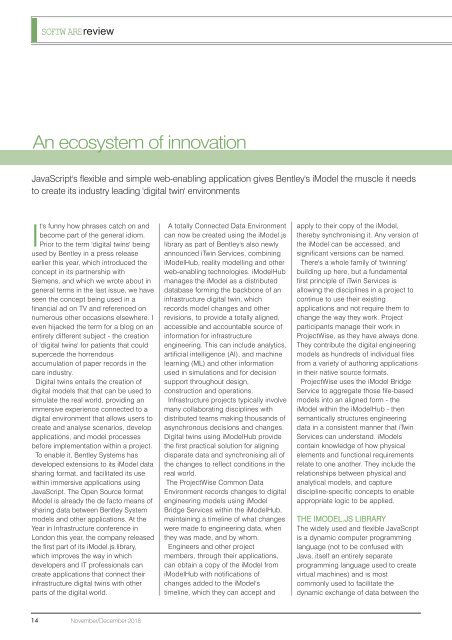CC1811
Create successful ePaper yourself
Turn your PDF publications into a flip-book with our unique Google optimized e-Paper software.
SOFTWARE review<br />
An ecosystem of innovation<br />
JavaScript's flexible and simple web-enabling application gives Bentley's iModel the muscle it needs<br />
to create its industry leading 'digital twin' environments<br />
It's funny how phrases catch on and<br />
become part of the general idiom.<br />
Prior to the term 'digital twins' being<br />
used by Bentley in a press release<br />
earlier this year, which introduced the<br />
concept in its partnership with<br />
Siemens, and which we wrote about in<br />
general terms in the last issue, we have<br />
seen the concept being used in a<br />
financial ad on TV and referenced on<br />
numerous other occasions elsewhere. I<br />
even hijacked the term for a blog on an<br />
entirely different subject - the creation<br />
of 'digital twins' for patients that could<br />
supercede the horrendous<br />
accumulation of paper records in the<br />
care industry.<br />
Digital twins entails the creation of<br />
digital models that that can be used to<br />
simulate the real world, providing an<br />
immersive experience connected to a<br />
digital environment that allows users to<br />
create and analyse scenarios, develop<br />
applications, and model processes<br />
before implementation within a project.<br />
To enable it, Bentley Systems has<br />
developed extensions to its iModel data<br />
sharing format, and facilitated its use<br />
within immersive applications using<br />
JavaScript. The Open Source format<br />
iModel is already the de facto means of<br />
sharing data between Bentley System<br />
models and other applications. At the<br />
Year in Infrastructure conference in<br />
London this year, the company released<br />
the first part of its iModel.js.library,<br />
which improves the way in which<br />
developers and IT professionals can<br />
create applications that connect their<br />
infrastructure digital twins with other<br />
parts of the digital world.<br />
A totally Connected Data Environment<br />
can now be created using the iModel.js<br />
library as part of Bentley's also newly<br />
announced iTwin Services, combining<br />
iModelHub, reality modelling and other<br />
web-enabling technologies. iModelHub<br />
manages the iModel as a distributed<br />
database forming the backbone of an<br />
infrastructure digital twin, which<br />
records model changes and other<br />
revisions, to provide a totally aligned,<br />
accessible and accountable source of<br />
information for infrastructure<br />
engineering. This can include analytics,<br />
artificial intelligence (AI), and machine<br />
learning (ML) and other information<br />
used in simulations and for decision<br />
support throughout design,<br />
construction and operations.<br />
Infrastructure projects typically involve<br />
many collaborating disciplines with<br />
distributed teams making thousands of<br />
asynchronous decisions and changes.<br />
Digital twins using iModelHub provide<br />
the first practical solution for aligning<br />
disparate data and synchronising all of<br />
the changes to reflect conditions in the<br />
real world.<br />
The ProjectWise Common Data<br />
Environment records changes to digital<br />
engineering models using iModel<br />
Bridge Services within the iModelHub,<br />
maintaining a timeline of what changes<br />
were made to engineering data, when<br />
they was made, and by whom.<br />
Engineers and other project<br />
members, through their applications,<br />
can obtain a copy of the iModel from<br />
iModelHub with notifications of<br />
changes added to the iModel's<br />
timeline, which they can accept and<br />
apply to their copy of the iModel,<br />
thereby synchronising it. Any version of<br />
the iModel can be accessed, and<br />
significant versions can be named.<br />
There's a whole family of 'twinning'<br />
building up here, but a fundamental<br />
first principle of iTwin Services is<br />
allowing the disciplines in a project to<br />
continue to use their existing<br />
applications and not require them to<br />
change the way they work. Project<br />
participants manage their work in<br />
ProjectWise, as they have always done.<br />
They contribute the digital engineering<br />
models as hundreds of individual files<br />
from a variety of authoring applications<br />
in their native source formats.<br />
ProjectWise uses the iModel Bridge<br />
Service to aggregate those file-based<br />
models into an aligned form - the<br />
iModel within the iModelHub - then<br />
semantically structures engineering<br />
data in a consistent manner that iTwin<br />
Services can understand. iModels<br />
contain knowledge of how physical<br />
elements and functional requirements<br />
relate to one another. They include the<br />
relationships between physical and<br />
analytical models, and capture<br />
discipline-specific concepts to enable<br />
appropriate logic to be applied.<br />
THE IMODEL.JS LIBRARY<br />
The widely used and flexible JavaScript<br />
is a dynamic computer programming<br />
language (not to be confused with<br />
Java, itself an entirely separate<br />
programming language used to create<br />
virtual machines) and is most<br />
commonly used to facilitate the<br />
dynamic exchange of data between the<br />
14<br />
November/December 2018

















